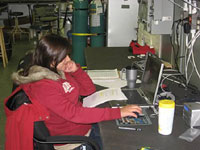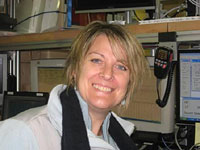

 | |||||||||||||||
|
|
Journals 2008/2009Steve Howard
August 15, 2008 This morning I woke up a bit before midnight, splashed some water on my face, and stumbled bleary-eyed down to the science lab where some of the lead scientists and a bank of high-powered computers were waiting for me. There are five of us on our watch, and always a lead scientist is nearby if anything unusual or problematic crops up. After an orientation, which my brain wasn't quite able to keep up with, we took our seats and began the watch. "Watch" is a good word for it too, because that is essentially what I do: watch the computer monitors and push a few buttons now and then when we come across sudden rises or drops in the seafloor profile or chunks of sea ice (we haven't hit ice yet, however) which can interfere with the echo-sounding system. The system produces a running record of data reports, and as long as they are coded green I can breathe easy. It also produces a visual image of the seafloor topography in brilliant color and remarkable detail, which is fascinating to watch unfold before your eyes. It all sounds deceptively simple, until you consider the time and expertise it took to develop these complex technological systems. In another area of the lab, other scientists are processing the incoming data and backing the record up on various hard drives. I enjoy listening to the experts around me interpret what they are seeing, and I'm learning about some new geological terms such as "scarp," "pockmark," and "scour" (I know they sound like skin afflictions, but they are really cool!) Today's project is running a "patch" test, which allows the team to calibrate the multibeam echo-sounder system and make sure that everything is running smoothly. This is important because it costs many tens of thousands of dollars per day to "rent" this vessel, so you can't afford to collect worthless data. By 5 or 6 am I was struggling a bit to stay awake, but some coffee, snacks, and an occasional chilly walk out on deck kept me alert. After my watch I had some chow and hit the sack for some much needed sleep. The rest of the day was spent working through photos I've taken and talking with other scientists about their work, but to be honest I haven't fully emerged from my drowsy state. With constant daylight, a rolling and pitching floor, and science team members coming and going at all hours with their projects, I can see it's going to take some time before I get the hang of this!
PROFILE:
|
||||||||||||||


